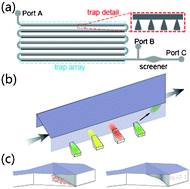A microfluidic synchronizer for fission yeast cells†
Abstract
Among all the cell cycle synchronization technologies, the baby machine may be considered as the most artifact-free method. A baby machine incubates “mother cells” under normal conditions and collects their “babies”, producing cell cultures that are similar not only in cell cycle phase but also in age. Unlike many other synchronization methods, no cell-cycle-blocking agent or metabolic stress is introduced in this method. Several macroscale and microfluidic baby machines have been developed for producing synchronized cell colonies. However, for rod-shaped cells like fission yeast (Schizosaccharomyces pombe), it is still a challenge to immobilize only the mother cells in a microfluidic device. Here we presented a new baby machine suitable for fission yeast. The device is fixed one end of the cell and releases the free-end daughter cell every time the cell finishes cytokinesis. A variety of structures for cell immobilization were attempted to find the optimal design. For the convenience of collection and further assay, we integrated into our baby machine chip a cell screener, which exploited the deformation of


 Please wait while we load your content...
Please wait while we load your content...